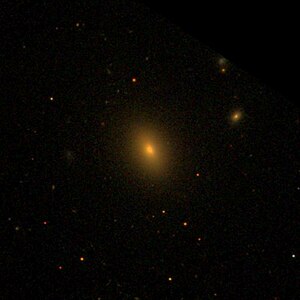Loading AI tools
Spiralgalaxie im Sternbild Widder Aus Wikipedia, der freien Enzyklopädie
NGC 1236 ist eine elliptische Galaxie vom Hubble-Typ E im Sternbild Widder auf der Ekliptik. Sie ist schätzungsweise 341 Millionen Lichtjahre von der Milchstraße entfernt und hat einen Durchmesser von etwa 90.000 Lichtjahren.
| Galaxie NGC 1236 | |
|---|---|
 | |
| SDSS-Aufnahme | |
| AladinLite | |
| Sternbild | Widder |
| Position Äquinoktium: J2000.0, Epoche: J2000.0 | |
| Rektaszension | 03h 11m 28,0s [1] |
| Deklination | +10° 48′ 30″ [1] |
| Erscheinungsbild | |
| Morphologischer Typ | E4[1] |
| Helligkeit (visuell) | 14,7 mag[2] |
| Helligkeit (B-Band) | 15,5 mag[2] |
| Winkelausdehnung | 0,9′ × 0,6′[2] |
| Positionswinkel | 27°[2] |
| Flächenhelligkeit | 13,9 mag/arcmin²[2] |
| Physikalische Daten | |
| Rotverschiebung | 0.025361 ± 0.000123[1] |
| Radialgeschwindigkeit | (7603 ± 37) km/s[1] |
| Hubbledistanz H0 = 73 km/(s • Mpc) |
(341 ± 24) · 106 Lj (104,4 ± 7,3) Mpc [1] |
| Durchmesser | 90.000 Lj[3] |
| Geschichte | |
| Entdeckung | Albert Marth |
| Entdeckungsdatum | 5. Oktober 1864 |
| Katalogbezeichnungen | |
| NGC 1236 • PGC 11898 • CGCG 441-003 • 2MASX J03112797+1048292 • NVSS J031127+104829 • NSA 155461 | |
Das Objekt wurde am 5. Oktober 1864 von dem Astronomen Albert Marth entdeckt.[4]
Seamless Wikipedia browsing. On steroids.
Every time you click a link to Wikipedia, Wiktionary or Wikiquote in your browser's search results, it will show the modern Wikiwand interface.
Wikiwand extension is a five stars, simple, with minimum permission required to keep your browsing private, safe and transparent.